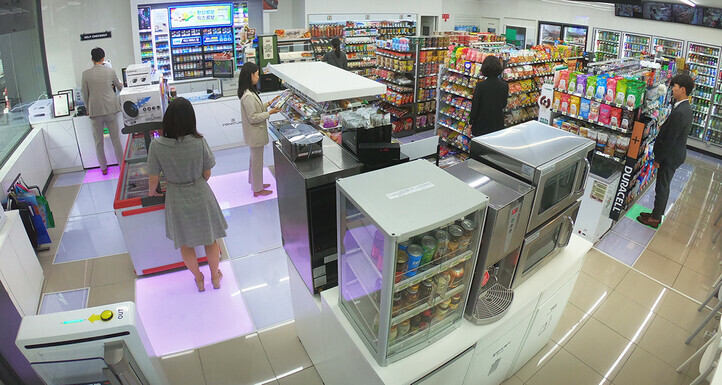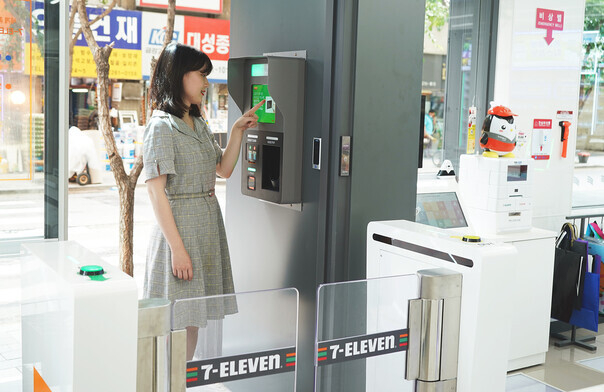hankyoreh
Links to other country sites 다른 나라 사이트 링크
Major convenience store chains experiment with automated branches in Seoul

The place was a 7-Eleven alongside a road in Seoul’s Jung (Central) District around midday on July 1. It did not look much different from other convenience stories -- but this one was a new “hybrid” form of automated store being unveiled by 7-Eleven for the first time along a major road. A hybrid convenience store is one that is staffed by a person during the day, but is automated midnight to 6 am. Customers during these hours are required to verify their identity at the door by credit card or Lotte membership barcode, and then again by a closed-circuit camera image of their face. They can search for their desired item on a monitor by the door, with the location identified by the lighting of a floor cell that appears at first glance like a tile. Customers must ring up their own purchases.
“While other automated stores only have the self-checkout, the advantage of this store is that it can be operated automatically even in a roadside commercial area thanks to the stronger security with dual identity verification,” explained Kim Young-hyeok, managing director and planning department chief for 7-Eleven Korea.
“We’re planning to explain the operating hours after a test run,” Kim added.

The race to establish automated stores has been heating up among convenience stores. South Korea’s convenience store chains have been working since the late 2010s to increase the number of automated establishments, with recent examples boasting stronger security and more advanced technology. The hybrid approach, which is the most common in the industry, was first introduced by CU in 2018 as a “buy-self store.” CU explained that the approach was used mainly in locations where permanent 24-hour staffing was less of an option. E-mart 24 and GS25 each introduced automated stores -- last year and early this year, respectively -- that adopt the “Amazon Go” model, eliminating checkout altogether. Customers using specific forms of simplified payment scan their QR code to enter, with the purchase taking place automatically as they exit the gate after selecting their items.
Industry observers said the use of automation has been an inevitable response to the increasingly broad range of convenience store services. In addition to their original duties involving orders, stocking, and checkout, convenience stores have also been recently dealing with an increase in duties such as chicken frying, laundry, and financial services -- one of the reason some netizens have begun referring to convenience store work as an “extreme” form of part-time employment.
“Convenience stores often have one person working alone, and it’s not realistic for them to hire more staff just because the amount of duties increases,” said one convenience store industry source.
“Even automated convenience stores require staff to do orders and stocking. The automated stores are efficient from an operational standpoint, allowing the staff to focus on other duties with the checkout part automated,” the source added.
Some observers have also stressed the need for automation to preserve the convenience store as an institution that operates 24 hours a day throughout the year. Another convenience store industry source said, “Some of the franchises are either struggling to find people to work at night or losing money staffing during late night hours when sales are not high.”
“Automating the stores during nighttime hours at least is a good way for these kinds of places to continue operating around the clock,” the source suggested.
But other observers voiced concern about the sense of the technological alienation that could arise among people unaccustomed to the methods as automated systems become more widespread. Just as older people have had difficulties using the kiosks that have become more common in grocery stores, some fear similar issues could arise within convenience stores. The fact that the checkout counter-free automated stores require a smartphone or credit card was also cited as a problem. Indeed, while Amazon Go initially announced plans to be a “cash-free” establishment, it backtracked last year amid criticisms that its approach discriminated against people without credit cards or smartphones.
By Shin Min-jung, staff reporter
Please direct comments or questions to [english@hani.co.kr]

Editorial・opinion
![[Editorial] Intensifying US-China rivalry means Seoul must address uncertainty with Beijing sooner than later [Editorial] Intensifying US-China rivalry means Seoul must address uncertainty with Beijing sooner than later](https://flexible.img.hani.co.kr/flexible/normal/500/300/imgdb/original/2024/0517/8117159322045222.jpg) [Editorial] Intensifying US-China rivalry means Seoul must address uncertainty with Beijing sooner than later
[Editorial] Intensifying US-China rivalry means Seoul must address uncertainty with Beijing sooner than later![[Column] When ‘fairness’ means hate and violence [Column] When ‘fairness’ means hate and violence](https://flexible.img.hani.co.kr/flexible/normal/500/300/imgdb/original/2024/0516/7417158465908824.jpg) [Column] When ‘fairness’ means hate and violence
[Column] When ‘fairness’ means hate and violence- [Editorial] Yoon must stop abusing authority to shield himself from investigation
- [Column] US troop withdrawal from Korea could be the Acheson Line all over
- [Column] How to win back readers who’ve turned to YouTube for news
- [Column] Welcome to the president’s pity party
- [Editorial] Korea must respond firmly to Japan’s attempt to usurp Line
- [Editorial] Transfers of prosecutors investigating Korea’s first lady send chilling message
- [Column] Will Seoul’s ties with Moscow really recover on their own?
- [Column] Samsung’s ‘lost decade’ and Lee Jae-yong’s mismatched chopsticks
Most viewed articles
- 1[Editorial] Transfers of prosecutors investigating Korea’s first lady send chilling message
- 2[Column] US troop withdrawal from Korea could be the Acheson Line all over
- 3[Column] When ‘fairness’ means hate and violence
- 4China calls US tariffs ‘madness,’ warns of full-on trade conflict
- 5[Editorial] Intensifying US-China rivalry means Seoul must address uncertainty with Beijing sooner t
- 6‘Shot, stabbed, piled on a truck’: Mystery of missing dead at Gwangju Prison
- 7Xi, Putin ‘oppose acts of military intimidation’ against N. Korea by US in joint statement
- 8[Exclusive] Unearthed memo suggests Gwangju Uprising missing may have been cremated
- 9Major personnel shuffle reassigns prosecutors leading investigations into Korea’s first lady
- 10[Editorial] Yoon must stop abusing authority to shield himself from investigation